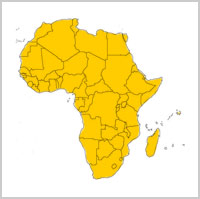 You don’t hear much about the state of the internet in Africa, so we here at Pingdom decided to find out how Africa’s internet is doing. We looked at data traffic and internet penetration (how many in the population have internet access), and came up with some very interesting numbers.
You don’t hear much about the state of the internet in Africa, so we here at Pingdom decided to find out how Africa’s internet is doing. We looked at data traffic and internet penetration (how many in the population have internet access), and came up with some very interesting numbers.
Bandwidth (traffic)
Internet exchange points (IXPs) are locations where internet service providers (ISPs) interconnect so that they can send traffic directly to each other instead of having this traffic routed via other providers (and potentially very long distances), cutting traffic costs and increasing performance in the process.
The IXP throughput can give us a good idea of how much internet traffic is being handled in Africa.
| Country | Name | City | Peering ISPs | Started | Traffic |
|---|---|---|---|---|---|
| Tanzania | AIXP | Arusha | 14 | 2007 | 200 Kbps |
| Angola | ANG-IXP | 5 | 2006 | Unknown | |
| Botswana | BINX | Gabarone | 8 | 2005 | Unknown |
| Egypt | CRIX | Cairo | 3 | 2005 | 12 Mbps |
| South Africa | GINX | Grahamstown | 6 | 2005 | 3 Mbps |
| Ghana | GIX | Accra | 24 | 2005 | Unknown |
| Nigeria | IBIX | Ibadan | 2 | 2003 | 200 Kbps |
| South Africa | JINX | Johannesburg | 24 | 1996 | 450 Mbps |
| Congo-Kinshasa | KINIX | Kinshasa | 12 | 2002 | 1 Mbps |
| Kenya | KIXP | Nairobi | 23 | 2002 | 14 Mbps |
| Mauritius | MIXP | Port Louis | 4 | 2005 | Unknown |
| Mozambique | MozIX | Maputo | 11 | 2002 | 5 Mbps |
| Nigeria | NIXP | Lagos | 15 | 2007 | Unknown |
| Rwanda | RINEX | Kigali | 2 | 2004 | 400 Kbps |
| Swaziland | SZIX | Mbabane | 3 | 2004 | 128 Kbps |
| Tanzania | TIX | Dar es Salaam | 14 | 2003 | 2 Mbps |
| Uganda | UIXP | Kampala | 9 | 2003 | 2.3 Mbps |
As you can see, the IXPs in Africa count their throughput in megabit per second, and sometimes even kilobit per second. The rest of the world tends to be concerned with gigabit per second.
To put the above numbers in perspective, here are the traffic numbers for some large IXPs outside Africa. We will let the data speak for itself here:
| Country | Name | City | Peering ISPs | Started | Traffic |
|---|---|---|---|---|---|
| Netherlands | AMS-IX | Amsterdam | 287 | 1997 | 413 Gbps |
| Germany | DE-CIX | Frankfurt | 229 | 1995 | 380 Gbps |
| United Kingdom | LINX | London | 221 | 1994 | 207 Gbps |
| Japan | JPNAP | Tokyo | 88 | 2001 | 183 Gbps |
| Sweden | Netnod | Stockholm | 53 | 1997 | 103 Gbps |
Internet penetration
The average internet penetration among the population in Africa is 4.7%. The world total is 20% (Europe and North America have 43.4% and 71.1% respectively). But even if the internet penetration is much lower in Africa compared to the rest of the world, it is nowhere near the order of magnitude that is being indicated by the IXP traffic.
Even though 4.7% may sound like a really small number, it is the equivalent of over 44 million people with internet access.
Broadband penetration, however, is much lower at a mere 0.1%. There were only 1,097,200 broadband subscribers in the whole of Africa as of September 2007. Most likely broadband connections are restricted mostly to major companies, schools and authorities.
Conclusion
Pingdom is based in Sweden, so we are spoiled with very good internet connections, and we take them for granted (as do many of you readers as well, we are sure).
Take a close look at the numbers in this post, because they really show how far behind Africa is on the internet. Hopefully significant progress will be made since the internet has become a vital part of the global economy. Africa will fall behind even more in the long run if they are not able to participate on the internet to the extent and capacity of the rest of the world.
Data sources:
We merged data from two different sources to get a relatively comprehensive list of African IXPs and their traffic: Association of African Internet Service Provider Associations, and the IXP directory at Packet Clearing House. We took the highest reported traffic values we could find when we merged the data.
The non-African IXP data is from Wikipedia.
The internet penetration data is from Internet World Stats.



























